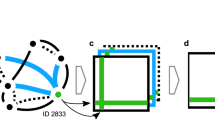Summary
The feral honey bee queens (colonies) of central New York State (USA) show a K-type life history strategy. Their demographic characteristics include low early life mortality, low reproductive rate, long lifespan, high population stability and repeated reproductions. Identifying the life history strategy of these bees reveals the general pattern of selection for competitive ability, rather than productivity, which has shaped their societies. Selection for competitive power explains the adaptiveness (compared with alternatives found in many other insect societies) of the large perennial colonies, infrequent but expensive offspring, and efficient foraging which characterize the social organization of these bees.
Similar content being viewed by others
References
Ambrose, J.T.: A study of honey bee (Apis mellifera L.) swarms while in transit to a new homesite. Ph.D. Thesis, Cornell Univ., Ithaca, N.Y. (1975)
Burgett, D.M., Morse, R.A.: The time of natural swarming in honey bees. Ann. Ent. Soc. Am. 67, 719–720 (1972)
Butler, C.G.: The process of queen supersedure in colonies of honeybees (Apis mellifera Linn.). Insectes Sociaux 4, 211–223 (1957)
Chandler, M.T.: The African honeybee-Apis mellifera adansonii: the biological basis of its management. Conference on apiculture in tropical climates, pp. 61–68 London: World Crops 1976
Edgell G.H.: The bee hunter. Cambridge, Mass. Harvard Univ. Press 1949
Fell, R.D., Ambrose, J.T., Burgett, D.M., DeJong, D., Morse, R.A., Seeley, T.D.: The seasonal cycle of swarming in honey bees. J. Apic. Res. (in press, 1977)
MacArthur, R.H., Wilson, E.O.: The theory of island biogeography. Princeton: Princeton Univ. Press 1967
Oertel, E.: Bicentennial bees: early records of honey bees in the eastern United States. Am. Bee J. 116, 70–71, 114, 128, 156–157, 214–215, 260–261, 290 (1976)
Ruttner, F.: Systematique du, genre Apis In: Traité de biologie de l'abeille, Vol. I (R. Chauvin, ed.), pp. 1–26. Paris: Masson 1968
Ruttner, F.: Races of bees. In: The hive and the honey bee (Dadant and Sons, eds.), pp. 19–38. Hamilton, Ill.: Dadant 1975
Ruttner, F.: Honeybees of the tropics: their variety and characteristics of importance for apiculture. Conference on apiculture in tropical climates, pp. 41–46. London: World Crops 1976
Seeley, T.D.: Measurement of nest cavity volume by the honey bee (Apis mellifera). Behav. Ecol. Sociobiol. 2, 201–227 (1977)
Seeley, T.D., Morse, R.A.: The nest of the honey bee (Apis mellifera L.). Insectes Sociaux 23, 495–512 (1976)
Simpson, J.: The amounts of hive-space needed by colonies of European Apis mellifera. J. Apic. Res. 8, 3–8 (1969)
Wilson, E.O.: The insect societies. Cambridge, Mass.: Harvard Univ. Press 1971
Wilson, E.O.: Sociobiology: the new synthesis. Cambridge, Mass. Harvard Univ. Press 1975
Author information
Authors and Affiliations
Rights and permissions
About this article
Cite this article
Seeley, T.D. Life history strategy of the honey bee, Apis mellifera . Oecologia 32, 109–118 (1978). https://doi.org/10.1007/BF00344695
Received:
Issue Date:
DOI: https://doi.org/10.1007/BF00344695




